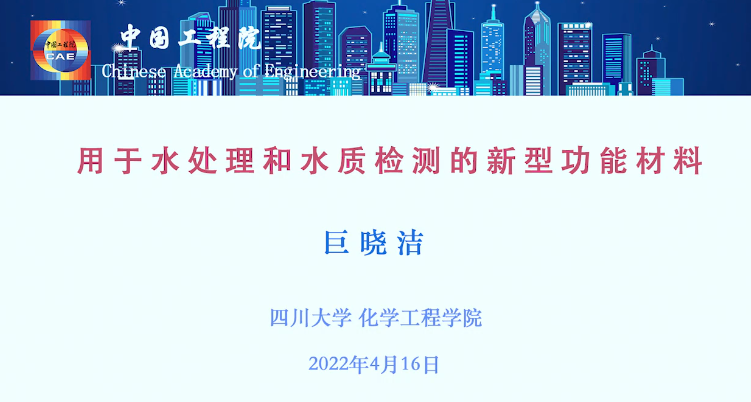检索范围:
排序: 展示方式:
Ting Zhang, Heze Liu, Yiyuan Zhang, Wenjun Sun, Xiuwei Ao
《环境科学与工程前沿(英文)》 2020年 第14卷 第3期 doi: 10.1007/s11783-020-1214-4
关键词: Drinking water Treatment process Genotoxicity Umu test Ecological Structure-Activity Relationship
Special issue on “Membranes and Water Treatment”
《化学科学与工程前沿(英文)》 2022年 第16卷 第5期 页码 561-563 doi: 10.1007/s11705-021-2136-9
Xiaojian ZHANG , Chao CHEN ,
《环境科学与工程前沿(英文)》 2009年 第3卷 第3期 页码 364-368 doi: 10.1007/s11783-009-0027-2
关键词: emergency drinking water treatment water pollution adsorption oxidation precipitation
Nanofiltration for drinking water treatment: a review
《化学科学与工程前沿(英文)》 2022年 第16卷 第5期 页码 681-698 doi: 10.1007/s11705-021-2103-5
关键词: nanofiltration drinking water disinfection byproducts micropollutants selectivity
Seasonal and treatment-process variations in invertebrates in drinking water treatment plants
Zhiling Wu, Xianchun Tang, Hongbin Chen
《环境科学与工程前沿(英文)》 2021年 第15卷 第4期 doi: 10.1007/s11783-020-1354-6
关键词: Invertebrates Drinking water Seasonal variations Treatment process
Recent advances in the electrochemical oxidation water treatment: Spotlight on byproduct control
Yang Yang
《环境科学与工程前沿(英文)》 2020年 第14卷 第5期 doi: 10.1007/s11783-020-1264-7
What have we known so far about microplastics in drinking water treatment? A timely review
《环境科学与工程前沿(英文)》 2022年 第16卷 第5期 doi: 10.1007/s11783-021-1492-5
• 23 available research articles on MPs in drinking water treatment are reviewed.
关键词: Microplastics Drinking water treatment Coagulation Flocculation Membrane Filtration
Haiyan Yang, Shangping Xu, Derek E. Chitwood, Yin Wang
《环境科学与工程前沿(英文)》 2020年 第14卷 第5期 doi: 10.1007/s11783-020-1254-9
关键词: Point-of-use water treatment Ceramic water filter Bacterial removal Surface modification Water quality
Locally enhanced electric field treatment (LEEFT) for water disinfection
Jianfeng Zhou, Ting Wang, Cecilia Yu, Xing Xie
《环境科学与工程前沿(英文)》 2020年 第14卷 第5期 doi: 10.1007/s11783-020-1253-x
关键词: Water treatment Nanotechnology Pathogen inactivation Electroporation Nanowire Chemical-free
Pengfei LIN,Xiaojian ZHANG,Hongwei YANG,Yong LI,Chao CHEN
《环境科学与工程前沿(英文)》 2015年 第9卷 第1期 页码 50-57 doi: 10.1007/s11783-014-0733-2
关键词: Arsenic spill chemical sedimentation coagulation drinking water emergency treatment
Using loose nanofiltration membrane for lake water treatment: A pilot study
《环境科学与工程前沿(英文)》 2021年 第15卷 第4期 doi: 10.1007/s11783-020-1362-6
• A pilot study was conducted for drinking water treatment using loose NF membranes.
关键词: Nanofiltration Drinking water Membrane fouling Aluminum carryover Chemical cleaning
From plasma to plasmonics: toward sustainable and clean water production through membranes
《化学科学与工程前沿(英文)》 2023年 第17卷 第12期 页码 1809-1836 doi: 10.1007/s11705-023-2339-3
关键词: water treatment membrane-based process plasma treatment plasma polymerization plasmonic light-to-heat conversion

Assessment of antibiotic resistance genes in dialysis water treatment processes
Xuan Zhu, Chengsong Ye, Yuxin Wang, Lihua Chen, Lin Feng
《环境科学与工程前沿(英文)》 2019年 第13卷 第3期 doi: 10.1007/s11783-019-1136-1
• Quantitative global ARGs profile in dialysis water was investigated. • Totally 35 ARGs were found in the dialysis treatment train. • 29 ARGs (highest) were found in carbon filtration effluent. • erm and mtrD-02 occurred in the final effluent. • The effluent was associated with health risks even after RO treatment.
关键词: Dialysis water Treatment process Antibiotic resistance gene High-throughput quantitative PCR Horizontal gene transfer
Adsorption in combination with ozonation for the treatment of textile waste water: a critical review
Shraddha Khamparia,Dipika Kaur Jaspal
《环境科学与工程前沿(英文)》 2017年 第11卷 第1期 doi: 10.1007/s11783-017-0899-5
关键词: Adsorption Ozonation Catalytic Ozonation Textile dyes Mineralization
标题 作者 时间 类型 操作
Comparative genotoxicity of water processed by three drinking water treatment plants with different watertreatment procedures
Ting Zhang, Heze Liu, Yiyuan Zhang, Wenjun Sun, Xiuwei Ao
期刊论文
Emergency drinking water treatment in source water pollution incident-technology and practice in China
Xiaojian ZHANG , Chao CHEN ,
期刊论文
Seasonal and treatment-process variations in invertebrates in drinking water treatment plants
Zhiling Wu, Xianchun Tang, Hongbin Chen
期刊论文
Recent advances in the electrochemical oxidation water treatment: Spotlight on byproduct control
Yang Yang
期刊论文
Ceramic water filter for point-of-use water treatment in developing countries: Principles, challenges
Haiyan Yang, Shangping Xu, Derek E. Chitwood, Yin Wang
期刊论文
Locally enhanced electric field treatment (LEEFT) for water disinfection
Jianfeng Zhou, Ting Wang, Cecilia Yu, Xing Xie
期刊论文
Applying chemical sedimentation process in drinking water treatment plant to address the emergent arsenicspills in water sources
Pengfei LIN,Xiaojian ZHANG,Hongwei YANG,Yong LI,Chao CHEN
期刊论文
巨晓洁:用于水处理和水检测的新型功能材料(2022年4月16日)
2022年06月09日
会议视频
Assessment of antibiotic resistance genes in dialysis water treatment processes
Xuan Zhu, Chengsong Ye, Yuxin Wang, Lihua Chen, Lin Feng
期刊论文








